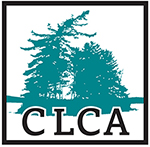 June Wildflowers
June Wildflowers June Wildflowers
June Wildflowers |
||
| Home | April-May | June | July | August-September | ||
| Photo (Click on image to see larger format image) | Description | Date (2015 season) |
 |
Dame's Rocket (commonly called Phlox): in late May and early June this plant flourishes along the sides of our roads and in open fields. Frequently mistaken for the native Phlox plant, Dame's Rocket is non-native introduced from Europe. Phlox has five petaled flowers, while Dame's Rocket's flowers have four petals. The plant has a high number of seeds and thus crowds out native plants. The plant should be considered to be an invasive. Massachusetts and Connecticut prohibit or ban this plant. (Thanks to Debbie Correll and Jane Davis for correcting this frequent confusion.) Non-native References: Chapman et al., p. 50; USDA
Photo: DC |
June 4 |
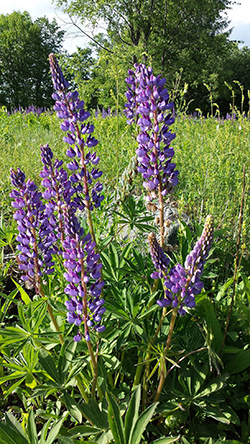 |
Wild Perennial Lupine (Sundial Lupone, Indian Beet, or Old Maid's Bonnet) : there are over 200 species of Lupines. A member of the legume family, seeds of lupines have been a food source for over 3000 years in the Mediterranean area and 6000 years in the Andes.
The Pinxter and Lily of the Valley are waning. References: Lady Bird Johnson Wild Flower Center; Wikipedia (general); Wikpedia (lupinus perennis) |
June 6 |
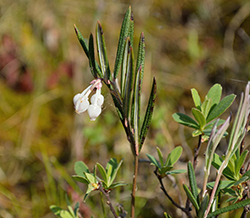 |
Bog Rosemary: a small native evergreen plant. Found in bogs and wetlands. Reference: Shrubs of the Adirondacks Photo: MA |
June 5 |
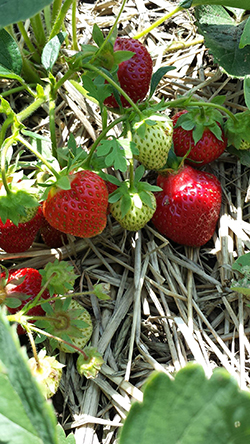 |
Strawberries are ready for picking!
Photo: DC. |
June 9 |
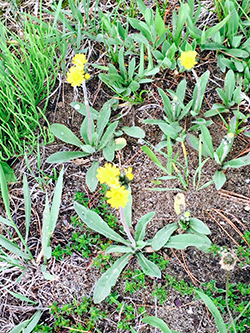 |
Yellow Hawkweed: Photo: AF |
June 9 |
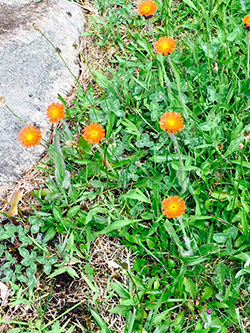 |
Orange Hawkweed or Devil's Paintbrush: a European import, Orange Hawkweed has spread rapidly in fields, clearings, and along roadsides. This rapid spread lead farmers to call the plant Devil's Paintbrush and to be considered one of the most notorious "weeds." By the end of June the orange flowers become fuzzy clusters of seed. There are native and alien species of hawkweed. A major difference is that the leaves of native plants ascend the plant wihile the leaves of the alien species have a rosette pattern at the base (basal). Picked flowers quickly close up and wilt. Non-native and is considered invasive in some areas. Reference: Minnesota Department of Natural Resources. Photos: AF and LL |
June 9 |
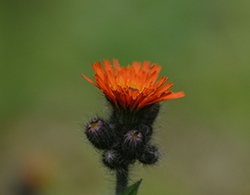 |
||
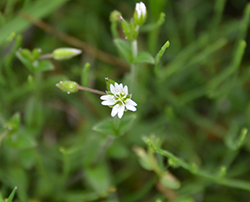 |
Chickweed: introduced from Europe and is now common throughout North America. Non-native References: Lady Bird Johnson Wildflower Center; Ohio Perennial & Birnnial Weed Guide. Photo: LL |
June 9 |
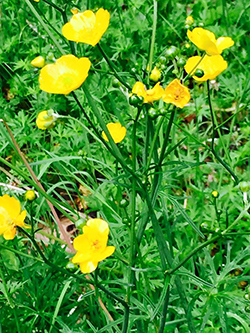 |
Common Buttercup, Meadow Buttercup, or Tall Buttercup (Ranunculus acris): probably introduced from Eurasia, this has become widespread throughout the U.S.. The plant can be found in a wide range of habitats including wet lowlands, woodlands, fields, and along roadsides. Non-native Reference: Ohio Perennial & Biennial Weed Guide.
Photos: AF |
June 9 |
 |
Wintergreen: this low growing shrub is native to the Adirondacks and eastern North America. The evergreen leaves have an oil with a wintergreen scent. The brilliant red fruits are edible with a minty flavor.
Sources: Paul Smith's; Wildflowers of the Adirondacks.
Photo: LL |
June 9 |
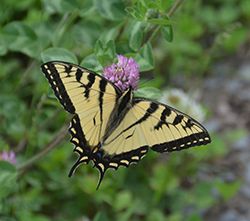 |
Eastern Tiger Swallowtail Butterflies: this species of swallowtail butterfly is one of the most famliar butterflies in the eastern U.S. The male is yellow with four black "tiger stripes" on each forewing. The female can be black or yellow. The yellow ones have evident blue spots along the back of the wing. The Eastern Tiger Swallowtail is most evident in June and early July. The name Swallowtail is based on the similarity of the butterfly's tail to that of a swallow. The Eastern Tiger Swallowtail is similar to the slightly smaller Canadian Tiger Swallowtail. The former are found in the southern portions of the Adirondacks while the Canadian Tiger Swallowtail appear in cooler areas to the north. Reference: Wikipedia Photos: LL |
June 9 |
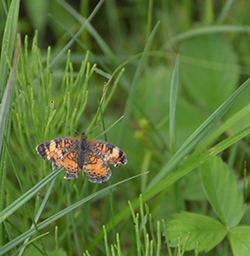 |
Pearl Crescent Butterfly: is found in all parts of the U.S. except the west coast. It can be found in open areas such as pastures and roadsides. The species has several broods and can be found from April to November in the north. Reference: Wikipedia; Butterflies of the Adirondacks. Photo: LL |
June 9 |
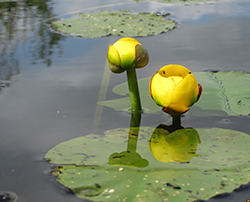 |
Yellow Pond Lily (Spatterdock): this native of the waters of the Adirondacks blooms in late spring and summer. The Spatterdock was a food source and was used medicinally by Native Americans. Native Reference: Paul Smith's; Wildflowers of the Adirondacks. Photos: LL |
June 10 |
 |
Common Daisy, Lawn Daisy, or English Daisy: the middle of June witnesses the blooming of Daisies and Queen Anne's Lace in fields and along the roadsides. Both are other European imports that have become naturalised in the U.S. Non-native Reference: Wikipedia Photos: LL |
June 10 |
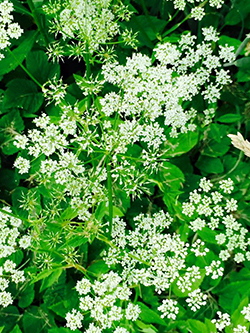 |
Queen Anne's Lace or Wild Carrot: native to Europe and Asia, Queen Anne's Lace has become naturalized in North America. It is not clear whether the name is in reference to Anne, Queen of England (reigned 1702-1707) or to her great grandmother Anne of Denmark (Queen Consort of England from 1603-1619). Reference: Wikipedia
Photo: AF |
June 10 |
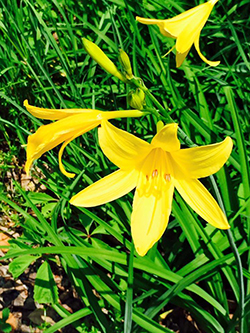 |
Yellow Daylily or Lemon-Lily: this is the first daylily to bloom each year. Daylilies are native to Asia. Since the 1930s, a wide variety of hybrids have been introduced. The most common types are the Yellow and Orange Daylilies which have "escaped" and are growing as if they are wild. Non-native Reference: Daylilies. Photo: AF |
June 10 |
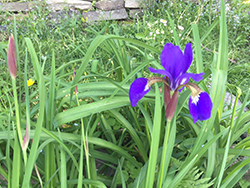 |
Blue Flag Iris: this is a native iris of the Adirondacks. It appears in swampland and wet meadows. The flower depends on polination by bees. Native References: Paul Smith's.; Lady Bird Johnson Wildflower Center; Wildflowers of the Adirondacks. Photos: JB & LL |
June 13 |
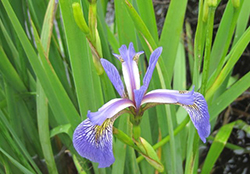 |
||
 |
Common Wood Sorrel:The plant is native to eastern North America. The wood sorrel is a low-growing plant with clover-like foliage and several white or pink flowers, with only 1 flower per stalk. Native References: Paul Smith's; Lady Bird Johnson Wildflower Center; Wildflowers of the Adirondacks. Photo: AF |
June 19 |
 |
Bladder Campion: native to Europe and widely spread in meadows and fields in North America. Shoot and leaves are used in food in the Mediterranean region. Non-native Reference: Wikipedia Photos: LL |
June 20 |
 |
Common Fleabane: belongs to the daisy family and is native to North America. Found on roadsides and fields. Native Reference: Wikipedia Photo: AF |
June 20 |
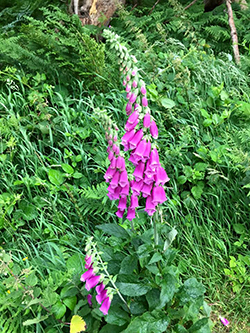 |
Foxgloves: native to western and southwestern Europe, western and central Asia, and northwestern Africa, Digitalis purpurea is a biennial plant often grown as an ornamental plant. Digitalis refers to the finger-like shape of the flowers. It is a poisonous plant, but a group of medicines known as digitalin have been extracted to treat heart conditions. Non-native Reference: Wikipedia Photo: SS |
June 21 |
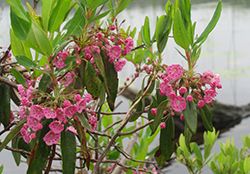 |
Sheep Laurel: is found in bogs and in moist wooodland soils. This evergreen shrub has a cluster of deep pink flowers. The flowers are similar to Bog Laurel except that the flowers on the latter appear at the top of the stem, while those of sheep laurel appear several inches below the top of the stem. The plant is also called Lambkill since the foliage is poisonous to livestock. Native Reference: Paul Smith's: Shrubs of the Adirondacks.
Photo: LL |
June 20 |
 |
Wild Strawberries are ripe
Photo: JB |
June 22 |
 |
Musk Mallow: sometimes white or lavender), musk-scented flowers in scattered groups at branch ends. Leaves: 3-4" (7.5-10 cm) wide, palmately divided into very narrow, toothed lobes. Height: 8-24". Native to Europe and southwestern Asia. Non-native Reference: Wikipedia Photo: JB |
June 22 |
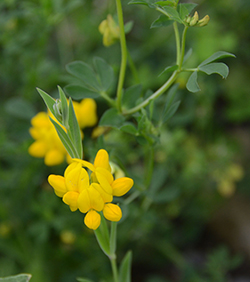 |
Birdsfoot Trefoil: a flowering plant in the pea family, native to temperate grassland areas in Eurasia. Used in agriculture as a forage plant. Mixed in feed for livestock since it does not cause bloating in ruminants. It has been planted along roadsides for erosion control. Non-native (invasive) Reference: Wikipedia Photo: LL |
June 25 |
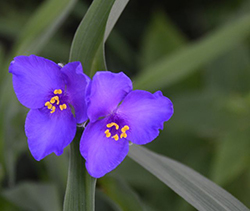 |
Spiderwort: native to the Americas from southern Canada to northern Argentina. Found in wooded areas. Some species open in the morning and close with the midday sun but remain open on cloudy days. Native Reference: Wikipedia Photo: LL |
June 25 |
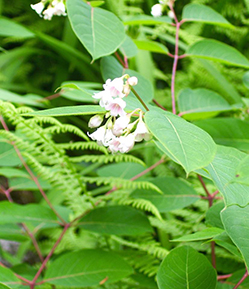 |
Dogbane: the name is derived from the plant's toxic nature, which is believed to be poisonous to dogs. The plant is also known as Indian Hemp since weaving together the plants stems produced cordage. The plants are relatives to milkweeds. It was once thought that Dogbane was a larval food for Monarch Butterlies, but more recent research has shown that while adult female monarchs are attracted to the plant, their larval offspring will not mature on it. Native References: Lady Bird Johnson's Wild Flower Center; Wikipedia; Wildflowers of the Adirondacks. Photo: BM |
June 25 |
 |
Pickerel Weed: an aquatic plant that grows in marshes, bogs, swamps, and shallow edges of ponds and streams. Native Reference: Wildflowers of the Adirondacks. Photos: LL |
June 25 |
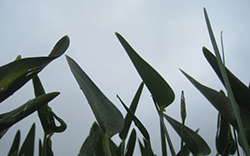 |
||
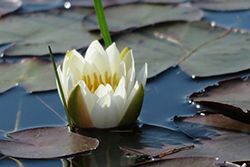 |
White water Lily: aquatic wildflower that produces fragrant and showy white flowers. Native Reference: Wildflowers of the Adirondacks. Photo: LL |
June 26 |
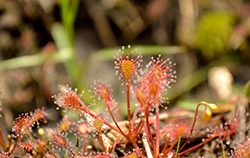 |
Spatulate-leaved sundew: or roundleaf Sundew, a small carnivorous plant that grows in acidic environments in boreal bogs. Native Reference: Wildflowers of the Adirondacks. Photo: MA |
June 28 |
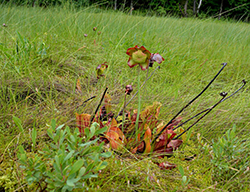 |
Purple Pitcher Plant: a carnivorous plant found in peat bogs in the Adirondacks. Native Reference: Wildflowers of the Adirondacks. Photo: MA& LL |
June 28 |
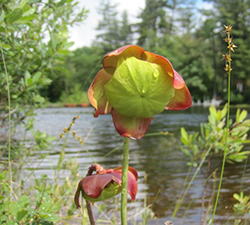 |
||
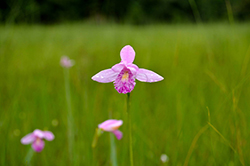 |
Rose Pogonia: an orchid found in bogs and moist meadows. Native Reference: Wildflowers of the Adirondacks. Photo: MA |
June 28 |
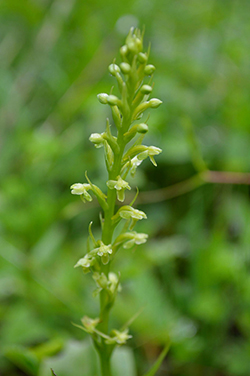 |
Northern tubercled bog orchid: is widely distributed across central and eastern Canada and the U.S. It is usually found in sunny wet meadows, swamps, and bogs. Native Reference: Northern American Orchid Center. Photos: MA |
June 28 |
 |
||
| Home | April-May | June | July | August-September | ||